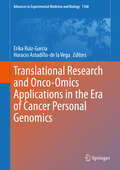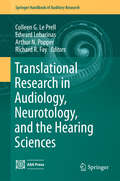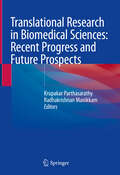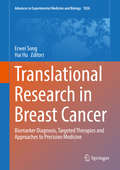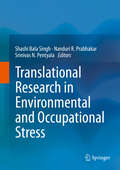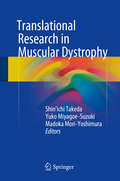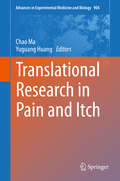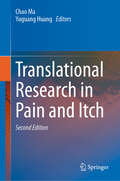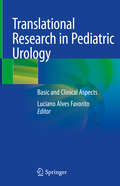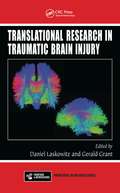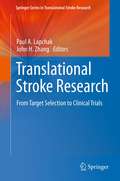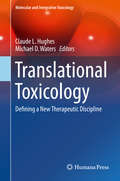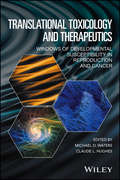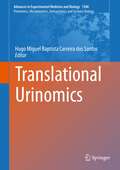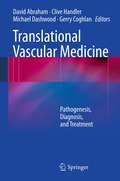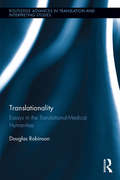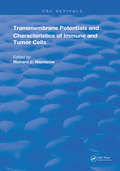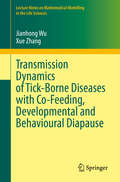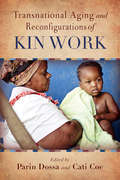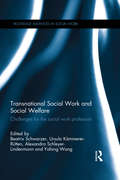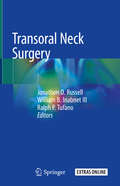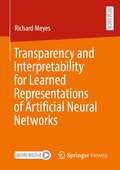- Table View
- List View
Translational Research and Onco-Omics Applications in the Era of Cancer Personal Genomics (Advances in Experimental Medicine and Biology #1168)
by Erika Ruiz-Garcia Horacio Astudillo-de la VegaBeing a complex disease that affects millions of people world over, cancer research has assumed great significance. Translational cancer research transforms scientific discoveries in the laboratory into clinical application to reduce incidence of cancer, morbidity and mortality. On the other hand, personalized medicine in cancer is the concept that selection of a treatment should be tailored according to the individual patient’s specific genomic characteristics, including mutations, chromosomal aberrations, protein interactions, and SNPs, and even more, taking into account the inmume system, the metabolism and maybe in the next future also the microbiome.
Translational Research in Audiology, Neurotology, and the Hearing Sciences
by Arthur N. Popper Richard R. Fay Colleen G. Le Prell Edward LobarinasTranslational Research is the interface between basic science and human clinical application, including the entire process from animal studies to human clinical trials (phases I, II, and III). Translational Research moves promising basic science results from the laboratory to bedside application. Yet, this transition is often the least-defined, least-understood part of the research process. Most scientific training programs provide little or no systematic introduction to the issues, challenges, and obstacles that prevent effective research translation, even though these are the key steps that enable high-impact basic science to ultimately result in significant clinical advances that improve patient outcome. This volume will provide an overview of key issues in translation of research from "bedside to bench to bedside", not only from the perspective of the key funding agencies, but also from the scientists and clinicians who are currently involved in the translational research process. It will attempt to offer insight into real-world experience with intellectual property and technology transfer activities that can help move auditory technologies ahead, as scientists and clinicians typically have little or no formal training in these areas. Translational Research in Audiology and the Hearing Sciences will be aimed at graduate students and postdoctoral investigators, as well as professionals and academics. It is intended to function as a high-profile and up-to-date reference work on Translational Research in the auditory sciences, emphasizing research programs in the traditional areas including drugs and devices, as well as less traditional, still emerging, areas such as sensorineural hearing loss, auditory processing disorder, cochlear implants and hearing aids, and tinnitus therapies.
Translational Research in Biomedical Sciences: Recent Progress and Future Prospects
by Krupakar Parthasarathy Radhakrishnan ManikkamThe main objective of translational health science is to concentrate on discovering healthcare products for all people where care gaps exist. This book examines the applications of translational research, identifies its difficulties, outlines its essential characteristics, considers healthcare management strategies, and examines the public's perspectives today. This book assists aspiring implementation scientists in researching this area because the discipline is still relatively young for the wide range of researchers tackling the challenge of clinical and translational science, a field dedicated to examining human health and disease, interventions, and outcomes to develop new treatment approaches, devices, and modalities to improve health. This book Edition is the most authoritative and timely resource that introduces new physiological and therapeutic processes to engage the fastest-growing scientific outcomes from academic and industrial research. The chapters in this book give insights into perspectives on the field of clinical and translational science and discuss artificial intelligence in drug development and conventional and novel clinical trial designs. There is a lot of hope that using artificial intelligence (AI) will significantly advance all facets of healthcare, from diagnosis to therapy. AI is prepared to assist medical staff with various duties, including administrative workflow, clinical documentation, patient outreach, and specialist support like image analysis, medical device automation, and patient monitoring. Some of the most important uses of AI in healthcare will be covered in this book by eminent Scientists, Academicians, and Industrial persons from both clinical and non-clinical fields.
Translational Research in Breast Cancer
by Erwei Song Hai HuThis book offers a comprehensive introduction to translational efforts in breast cancer, addressing the latest approaches to precision medicine based on the current state of understanding of breast cancer. With the latest developments in breast cancer research, our understanding of the genomic changes and the oncogenic signaling cascade of breast cancer has made considerable strides. Further, the immuno-environment has been demonstrated as the barrier to clinical cancer. In addition, major advances in cancer biology, immunology, genomics and metabolism have broken new ground for designing therapeutic approaches and selecting appropriate treatments on the basis of more precise information on the individual patient. As a result of these two trends, a clearer picture of the molecular landscape of breast cancers has facilitated the development of diagnostic, prognostic and predictive biomarkers for clinical oncology. All these aspects are addressed in this volume, which offers a comprehensive resource for researchers, graduate students and oncologists in cancer research.
Translational Research in Breast Cancer (Advances in Experimental Medicine and Biology #1187)
by Masakazu Toi Dong-Young Noh Wonshik HanThis book describes recent advances in translational research in breast cancer and presents emerging applications of this research that promise to have meaningful impacts on diagnosis and treatment. It introduces ideas and materials derived from the clinic that have been brought to "the bench" for basic research, as well as findings that have been applied back to "the bedside". Detailed attention is devoted to breast cancer biology and cell signaling pathways and to cancer stem cell and tumor heterogeneity in breast cancer. Various patient-derived research models are discussed, and a further focus is the role of biomarkers in precision medicine for breast cancer patients. Next-generation clinical research receives detailed attention, addressing the increasingly important role of big data in breast cancer research and a wide range of other emerging developments. An entire section is also devoted to the management of women with high-risk breast cancer. Translational Research in Breast Cancer will help clinicians and scientists to optimize their collaboration in order to achieve the common goal of conquering breast cancer.
Translational Research in Environmental and Occupational Stress
by Shashi Bala Singh Nanduri R. Prabhakar Srinivas N. PentyalaCutting edge technologies can propel a simple finding in basic science to a concept that can be of immense value to the society. While applying novel techniques to unravel the mysteries of biological processes, an offshoot of applied branch emerged. This field, which is now widely referred to as Translational Research utilizes basic science findings and translates these findings into innovative concepts for the benefit of mankind. This branch of science has evolved into a multidisciplinary juggernaut encompassing all known fields of science as varied as biomedicine, environment, law, economics, sociology, etc. With the ever increasing interest in this branch and the dreams and aspirations that this field can bring, basic science researchers are now taking a bold step into this new realm, merging different fields of knowledge to come up with novel inventions. This book "Translational research in environmental and occupational stress" provides and insight into the research that led to discoveries, inventions and development of novel technologies which will have a tremendous impact on the future of mankind.
Translational Research in Muscular Dystrophy
by Shin'Ichi Takeda Yuko Miyagoe-Suzuki Madoka Mori-YoshimuraThis book presents recent advances in translational research on muscular dystrophy (MD) to physicians and researchers, including cutting-edge research on the disease such as regenerative medicine, next-generation DNA sequencing, and nucleic acid therapies. It also describes the current systems for clinical trials and MD patient databases, resources, which will support the early realization of clinical application and improve patients' quality of life. MD is the one of the most widely known inherited neuromuscular diseases and is classified into diverse types by symptoms, age of onset, mode of inheritance, and clinical progression. With the development of molecular biology, the occurrence mechanisms of each type of MD are gradually being elucidated. Although there is no known permanent cure yet, the stage of treatment research has now advanced to clinical trials.
Translational Research in Pain and Itch
by Chao Ma Yuguang HuangThis book provides a comprehensive review of the latestadvances in translational pain and itch research, and presents the cutting-edgedevelopments in the study of our two principal, yet most mysteries sensations. Despitethe slow progress in the discovery of effective therapies for chronic pain andpruritus, scientists around the globe now have a better understanding of whyand how these conditions occur. Based on these findings, a series of noveltreatment strategies are currently under development, and hopefully in a fewyears, medical practitioners will become more confident and optimistic whenfacing patients with these annoying and sometimes severe disorders. Thecontributing authors are world-renowned research scientists, who have madesignificant discoveries. The book is ofinterest to neuroscientists, neurologists and pharmacologists
Translational Research in Pain and Itch
by Chao Ma Yuguang HuangThis book provides a comprehensive review of the latest advances in translational pain and itch research, and presents the cutting-edge developments in the study of our two principal, yet most mysteries sensations. Despite the slow progress in the discovery of effective therapies for chronic pain and pruritus, scientists around the globe now have a better understanding of why and how these conditions occur. Based on these findings, a series of novel treatment strategies are currently under development, and hopefully in a few years, medical practitioners will become more confident and optimistic when facing patients with these annoying and sometimes severe disorders. The contributing authors are world-renowned research scientists, who have made significant discoveries. The book is of interest to neuroscientists, neurologists and pharmacologists in both clinical and basic medical research field. In this second edition of the book, five existing chapters have been updated. Five new chapters have been added to reflect the lasted developments in the related field of research.
Translational Research in Pediatric Urology: Basic and Clinical Aspects
by Luciano Alves FavoritoTranslational research is of great importance for clinical practice. Therefore, this book provides comprehensive information on an important gap in pediatric urology: the description of basic concepts that allow a better understanding of urinary and genital anomalies. The content encompasses personal experience and research topics developed at Rio de Janeiro State University’s Urogenital Research Unit over the past 25 years. Throughout the chapters, the main aspects of embryology and fetal anatomy as applied to the various congenital malformations that most often affect newborns and children are described. Neural tube defects and Prune Belly Syndrome, two rare but highly relevant conditions that alter the structure of the urinary and genital system, are discussed in detail. In addition, the diagnosis and treatment of genital anomalies are addressed. Given its scope, the book offers a valuable resource for a wide audience including urologists, pediatricians, pediatric surgeons, and medical students.
Translational Research in Stroke
by Paul A. Lapchak Guo-Yuan YangThis volume sets a basis for effective translational research. Authored by experts in the field of translational stroke research, each chapter specifically addresses one or more components of preclinical stroke research. The emphasis is placed on target identification and drug development using state-of-the-art in vitro and in vivo assays, in combination with in vitro toxicology assays, AMDE and clinical design.
Translational Research in Traumatic Brain Injury (Frontiers In Neuroscience Ser.)
by Daniel Laskowitz Gerald GrantTraumatic brain injury (TBI) remains a significant source of death and permanent disability, contributing to nearly one-third of all injury related deaths in the United States and exacting a profound personal and economic toll. Despite the increased resources that have recently been brought to bear to improve our understanding of TBI, the developme
Translational Stroke Research
by Paul A. Lapchak John H. ZhangThis volume sets a basis for effective translational research. Authored by experts in the field of translational stroke research, each chapter specifically addresses one or more components of preclinical stroke research. The emphasis is placed on target identification and drug development using state-of-the-art in vitro and in vivo assays, in combination with in vitro toxicology assays, AMDE and clinical design.
Translational Toxicology
by Claude L. Hughes Michael D. WatersBringing together adistinguished interdisciplinary team of contributors, this volumeprovides a comprehensive exploration of translational toxicology--a systematicapproach to developing therapeutic interventions that can protect against,mitigate, or reverse the effects of exposures. In particular, the bookaddresses modes of action and biomarkers, developmental risks of exposures, andpotential translational toxicology therapeutics. The result is a compellingapplication of developmental toxicology in a new therapeutic discipline that isdestined to become part of standard medical practice. TranslationalToxicology: Defining a New Therapeutic Discipline is an essential text for regulatory authorities, scientists, andphysicians who are concerned with environmental exposures, public health, nutrition,and pharmaceutical research and development. Basic science, epidemiological,and clinical investigators will also find this book a significant resource.
Translational Toxicology and Therapeutics: Windows of Developmental Susceptibility in Reproduction and Cancer
by Claude L. Hughes Michael D. WatersWritten by leading research scientists, this book integrates current knowledge of toxicology and human health through coverage of environmental toxicants, genetic / epigenetic mechanisms, and carcinogenicity. Provides information on lifestyle choices that can reduce cancer risk Offers a systematic approach to identify mutagenic, developmental and reproductive toxicants Helps readers develop new animal models and tests to assess toxic impacts of mutation and cancer on human health Explains specific cellular and molecular targets of known toxicants operating through genetic and epigenetic mechanisms
Translational Urinomics (Advances in Experimental Medicine and Biology #1306)
by Hugo Miguel Baptista Carreira dos SantosTranslational Urinomics provides an overview of urine analysis using proteomics, metabolomics, transcriptomics or any combination thereof for the diagnosis and prognosis of diseases related to the urinary system and the kidneys. The text approaches urine biomarkers from a new perspective, incorporating up-to-date studies of mass-spectrometry-based biomarker discovery as well as the latest advances in personalized medicine. The integration of technology-driven techniques, such as OMICS also provides a unique opportunity for improved diagnostics accuracy of urinary-related diseases. For nephrologists and urologists looking for new approaches to well-known problems, this edited volume serves as a valuable guide.
Translational Vascular Medicine
by Michael Dashwood Gerry Coghlan Clive Handler David AbrahamTranslational medicine underpins vascular medicine. It is fundamental to understanding how we treat patients with vascular disease and more importantly, how to prevent it. It is the rationale for drug design and production. Vascular medicine and translational medicine will take over and become the main reason for referring patients to hospital. Therefore, hospital-based clinicians working with basic scientists need to know about translational medicine, which educates and informs them about vascular medicine and how management should be based. This book is a primer for translational vascular medicine and discusses the evolving and exciting areas of basic science applied to vascular medicine. The book is based on the third vascular biology conference held at The Royal College of Physicians in 2008. It provides a large amount of new basic and clinical information and the contributors are world leaders.
Translationality: Essays in the Translational-Medical Humanities (Routledge Advances in Translation and Interpreting Studies)
by Douglas RobinsonThis book defines "translationality" by weaving a number of sub- and interdisciplinary interests through the medical humanities: medicine in literature, the translational history of medical literature, a medical (neuroscience) approach to literary translation and translational hermeneutics, and a humanities (phenomenological/performative) approach to translational medicine. It consists of three long essays: the first on the traditional medicine-in-literature side of the medical humanities, with a close look at a recent novel built around the Capgras delusion and other neurological misidentification disorders; the second beginning with the traditional history-of-medicine side of the medical humanities, but segueing into literary history, translation history, and translation theory; the third on the social neuroscience of translational hermeneutics. The conclusion links the discussion up with a humanistic (performative/phenomenological) take on translational medicine.
Transmembrane Potentials & Characters Immune & Tumor Cell (Routledge Revivals)
by Richard C. NiemtzowFirst Published in 1979, this book offers a full, comprehensive guide into the potential application of immune and tumor cells. Carefully compiled and filled with a vast repertoire of notes, diagrams, and references this book serves as a useful reference for students of oncology, and other practitioners in their respective fields.
Transmission Dynamics of Tick-Borne Diseases with Co-Feeding, Developmental and Behavioural Diapause (Lecture Notes on Mathematical Modelling in the Life Sciences)
by Jianhong Wu Xue ZhangThis monograph introduces some current developments in the modelling of the spread of tick-borne diseases. Effective modelling requires the integration of multiple frameworks. Here, particular attention is given to the previously neglected issues of tick developmental and behavioral diapause, tick-borne pathogen co-feeding transmission, and their interactions. An introduction to the required basics of structured population formulations and delay differential equations is given, and topics for future study are suggested. The described techniques will also be useful in the study of other vector-borne diseases. The ultimate aim of this project is to develop a general qualitative framework leading to tick-borne disease risk predictive tools and a decision support system. The target audience is mathematical biologists interested in modelling tick population dynamics and tick-borne disease transmission, and developing computational tools for disease prevention and control.
Transnational Aging and Reconfigurations of Kin Work
by Parin Dossa Cati Coe Delores V. Mullings Erin L. Raffety Karen Kobayashi Kristin Elizabeth Yarris Loretta Baldassar Mushira Mohsin Khan Neda Deneva Yanqiu Rachel ZhouTransnational Aging and Reconfigurations of Kin Work documents the social and material contributions of older persons to their families in settings shaped by migration, their everyday lives in domestic and community spaces, and in the context of intergenerational relationships and diasporas. Much of this work is oriented toward supporting, connecting, and maintaining kin members and kin relationships—the work that enables a family to reproduce and regenerate itself across generations and across the globe.
Transnational Social Work and Social Welfare: Challenges for the Social Work Profession (Routledge Advances in Social Work)
by Beatrix Schwarzer Ursula Kämmerer-Rütten Alexandra Schleyer-Lindenmann Yafang WangThe underlying frame of social work is the nation state, and it is from within the state that welfare strategies and social policies are devised and implemented. However, post-colonialism, globalisation, migration and the associated implications for human rights, social justice and social welfare policies contest the idea of a clearly defined space for social work and present new challenges for researchers and practitioners. Transnational Social Work and Social Welfare argues for the increased importance of the transnational perspective in social work theory and practice. The book challenges the idea of the nation state as a given entity and argues that globalization and an increasing number of people crossing borders must have an impact on the theories and strategies of social work. The international contributors are critical of a restricted focus on a geographically defined space and the impact on work with clients. With cases covering China, France, India, UK, Germany, Malaysia, Israel, Turkey, the book highlights the challenges as well as the opportunities this new perspective can open up for theories and strategies in social work. It will be of interest to students, researchers and social workers interested in migration, social care, poverty and cultural competency in health and social care.
Transnational Social Work and Social Welfare: Challenges for the Social Work Profession (Routledge Advances in Social Work)
by Beatrix Schwarzer Ursula Kämmerer-Rütten Alexandra Schleyer-Lindenmann Yafang WangThe underlying frame of social work is the nation state, and it is from within the state that welfare strategies and social policies are devised and implemented. However, post-colonialism, globalisation, migration and the associated implications for human rights, social justice and social welfare policies contest the idea of a clearly defined space for social work and present new challenges for researchers and practitioners. Transnational Social Work and Social Welfare argues for the increased importance of the transnational perspective in social work theory and practice. The book challenges the idea of the nation state as a given entity and argues that globalization and an increasing number of people crossing borders must have an impact on the theories and strategies of social work. The international contributors are critical of a restricted focus on a geographically defined space and the impact on work with clients. With cases covering China, France, India, UK, Germany, Malaysia, Israel, Turkey, the book highlights the challenges as well as the opportunities this new perspective can open up for theories and strategies in social work. It will be of interest to students, researchers and social workers interested in migration, social care, poverty and cultural competency in health and social care.
Transoral Neck Surgery
by William B. Inabnet III Ralph P. Tufano Jonathon O. RussellThis text will serve as a guide for both the head and neck surgeon and the general surgeon in the technical and clinical aspects of transformative transoral neck surgery. It provides the reader with a comprehensive understanding of transoral approaches, including surgical indications, techniques, and outcomes. Such indications include thyroid disease, parathyroid disease, neck dissection, and other head and neck pathology. Instrumentation, setup, and the role of additional technologies such as nerve monitoring and robotics are reviewed in depth, followed by additional chapters on techniques, pearls, pitfalls, controversies, and challenging cases. The volume concludes with the current state of robotics in transoral surgery, and takes a look at future directions. Written and edited by experts in the field, Transoral Neck Surgery will be a valuable guide for the thousands of clinicians implementing this surgery.
Transparency and Interpretability for Learned Representations of Artificial Neural Networks
by Richard MeyesArtificial intelligence (AI) is a concept, whose meaning and perception has changed considerably over the last decades. Starting off with individual and purely theoretical research efforts in the 1950s, AI has grown into a fully developed research field of modern times and may arguably emerge as one of the most important technological advancements of mankind. Despite these rapid technological advancements, some key questions revolving around the matter of transparency, interpretability and explainability of an AI’s decision-making remain unanswered. Thus, a young research field coined with the general term Explainable AI (XAI) has emerged from increasingly strict requirements for AI to be used in safety critical or ethically sensitive domains. An important research branch of XAI is to develop methods that help to facilitate a deeper understanding for the learned knowledge of artificial neural systems. In this book, a series of scientific studies are presented that shed light on how to adopt an empirical neuroscience inspired approach to investigate a neural network’s learned representation in the same spirit as neuroscientific studies of the brain.
